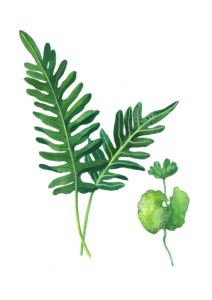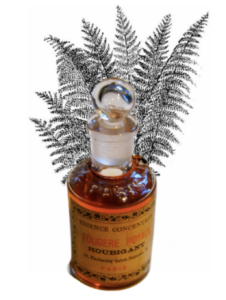 Queer Affinities in Plath’s The Bell Jar: Olfaction, Eroticism, Ferns
Queer Affinities in Plath’s The Bell Jar: Olfaction, Eroticism, Ferns
By Chlo Gold (’25)
Sylvia Plath’s The Bell Jar is often remembered for its parallels between the experiences of Esther—the novel’s main character—and those of Plath herself. Yet, what about the novel’s other players? How might focus on those characters inform our understanding of the novel and about Plath herself? Doreen is one such character. Esther’s closest friend in their intern cohort at Ladies’ Day magazine, she is subversive in her disregard for conventionality. Doreen is botanically charged, oozing sensuality, and particularly odorous—her strange confidence and articulation of womanhood are both disgusting and enticing to Esther. Attuned to Doreen, olfaction, and the novel’s more-than-human performers, including ferns, we find a pungent queerness that opens up new interpretive possibilities for The Bell Jar.
Olfaction is culturally positioned as a marginal sense and as chemically volatile, analogous to a queer theoretical embrace of outsider status and destabilization of heteronormativity. Within The Bell Jar specifically, olfaction is a polluting force, just as queerness is viewed by right-wing agendas as infectious and dangerous. Ferns, too, can be esteemed as a rich, botanical signifier of queerness, as evident in their “atypical” growth habits and mystical, folkloric regard. The spores they use in reproduction are nearly invisible and carried by the wind—emanating from the dark underside of the leaf. Moreover, ferns are often considered inferior to seed-producing and flowering plants, which are lauded as the most successful in terms of their species diversity and relative abundance. When fern and scent come together, and superimpose upon Doreen, these three potent players coalesce to form undeniable and suffusive queerness.
Doreen is a heavily scented character and described as such on multiple occasions. Her smell is overwhelming and overpowering, “strong as a whole perfume store,” rather than the dainty and discrete scent associated with traditional femininity. She is rank, smelling of sweat and musk, a scent that is wild, untameable, and perhaps masculine. Most importantly, she smells of fern—and is described erotically (Plath 2005: 5):
Doreen wore these full length nylon and lace jobs you could half see through, and dressing gowns the colour of skin, that stuck to her by some kind of electricity. She had an interesting, slightly sweaty smell that reminded me of those scallopy leaves of sweet fern[1] you break off and crush between your fingers for the musk of them.

The fern scent ascribed to Doreen is most likely fougère fragrance, a category of perfumes whose name means “fern-like” in French. These perfumes were initially designed in the late 19th century with the intention to be worn by men. By the 1940s and 1950s, women wore animalistic scents as a small, but mighty means of asserting autonomy: while they were disenfranchised at the. hands of sexist norms, their scents carried character, power and depth. Image by Chlo Gold.
Esther is left confused and repulsed by Doreen’s apparent sensuality, leading her to take hot baths to physically purge the feeling. It is clear, from this reaction, that Esther is particularly offended by the remnant of Doreen that lingers when she is no longer in sight. Her smell, pungent in the air, is what Esther is scrubbing away as she bathes. Thus, her smell becomes inextricably connected with Esther’s desire, as well as her fear over this queer desire. Doreen’s odor is of particular concern and vexation, as it does not align with her gender expression; her masculine fern-scent belies conventional womanhood. Visibly, Doreen reads as a woman, yet her olfactory “appearance” tempers femininity with androgyny and gender nonconformity. The scent of ferns, herein, comes to signify an individual’s “correct” expression of their gender and signals to the reader that Doreen’s identity is suspicious. As a result, this fern-scent is an encapsulation of deviance in the face of heteropatriarchy that Esther at once fears and feels incapable of embracing, yet deeply craves.
Esther’s quasi-queerness has connotations for Plath’s own. While Plath herself was surely not queer in terms of sexuality, her “bent” stance on child-rearing alongside a fruitful literary career would be considered deviant and her grand ambitions perverse. Plath demonstrated fierce desires for the natural entropy of the world—especially botanical growth—and an aversion to roles scripted by society and policed through surveillance, such as heteronormativity, suburbia, domesticity, and gender identity. In order to escape these confines, Plath wrote of a wilderness within and conjured a lush, unfettered smell-scape, imbuing queer desires for such in Esther. With this, she presents us with a proto-queer theory that transcends her time, urging us to apply this lens to her own novel. We must answer this call and draw our attention to the margins: a focus that engages olfaction rather than merely sight, a curiosity that witnesses the fiddleheads emerging on the forest floor, and an admiration for the ripe queerness of the world.
Works Cited
Hitchman, Beatrice. 2019. “‘Minor Scandal’: Lesbian Writing Contexts for The Bell Jar.” Sylvia Plath in Context, edited by Tracy Brain, pp. 169–179. Cambridge: Cambridge University Press.
Plath, Sylvia. 2005. The Bell Jar. Princeton, NJ: Harper Perennial Modern Classics.
Notes
[1] Technically speaking, sweetferns (Comptonia peregrina) are not true ferns—rather they are angiosperms that closely resemble a fern’s form. However, the rank scent Esther describes more closely aligns with a traditional fern fragrance, derived from the Common Male Fern. See The Bell Jar pp. 47-48 for additional quotes on Doreen and odor. See Hitchman (2019) for more on queerness and The Bell Jar.